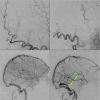High grade torcular DAVF: Technical aspects to safely sacrifice the straight sinus
- PMID: 40762170
- PMCID: PMC12325241
- DOI: 10.1177/19714009251362825
High grade torcular DAVF: Technical aspects to safely sacrifice the straight sinus
Abstract
High grade torcular DAVFs can be challenging to treat, particularly when there is retrograde flow in the straight sinus and deep venous system. We describe the technical steps to safely sacrifice the straight sinus, including preoperative MRI findings, arterial and venous cerebral flow assessment and key points for endovascular treatment.
Keywords: DAVF; Dural arteriovenous fistula; embolization; isolated DAVF; isolated dural arteriovenous fistula; isolated sinus; surgery.
Conflict of interest statement
The author(s) declared no potential conflicts of interest with respect to the research, authorship, and/or publication of this article.
Figures






Similar articles
-
Bilateral Thalamic Edema Caused by Tentorial Galenic Dural Arteriovenous Fistula and Sinus Thrombosis: Successful Endovascular Therapy.Turk Neurosurg. 2025;35(4):667-671. doi: 10.5137/1019-5149.JTN.47423-24.1. Turk Neurosurg. 2025. PMID: 40577497
-
Parasagittal and Superior Sagittal Sinus Dural Arteriovenous Fistulas: Clinical Presentations, Imaging Characteristics, and Treatment Strategies.AJNR Am J Neuroradiol. 2024 Aug 9;45(8):1025-1030. doi: 10.3174/ajnr.A8246. AJNR Am J Neuroradiol. 2024. PMID: 38479780 Free PMC article.
-
Dural arteriovenous fistulas of the hypoglossal canal: systematic review on imaging anatomy, clinical findings, and endovascular management.J Neurosurg. 2015 Apr;122(4):883-903. doi: 10.3171/2014.10.JNS14377. Epub 2014 Nov 21. J Neurosurg. 2015. PMID: 25415064
-
Superior sagittal sinus dural arteriovenous fistulas: navigating the complexity of treatment strategies and outcomes.J Clin Neurosci. 2025 Aug 6;140:111544. doi: 10.1016/j.jocn.2025.111544. Online ahead of print. J Clin Neurosci. 2025. PMID: 40773855
-
De Novo dural arteriovenous fistulas after endovascular treatment: Case illustration and literature review.Interv Neuroradiol. 2024 Aug;30(4):597-603. doi: 10.1177/15910199221118517. Epub 2022 Aug 4. Interv Neuroradiol. 2024. PMID: 35924383 Free PMC article. Review.
References
-
- van Dijk JM, terBrugge KG, Willinsky RA, et al. Clinical course of cranial dural arteriovenous fistulas with long-term persistent cortical venous reflux. Stroke 2002; 33: 1233–1236. - PubMed
-
- Osada T, Krings T. Intracranial dural arteriovenous fistulas with pial arterial supply. Neurosurgery 2019; 84: 104–115. - PubMed
LinkOut - more resources
Full Text Sources

